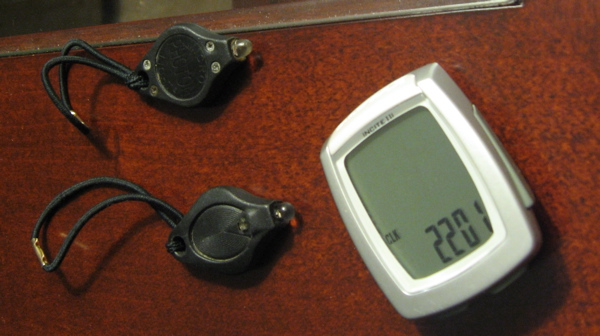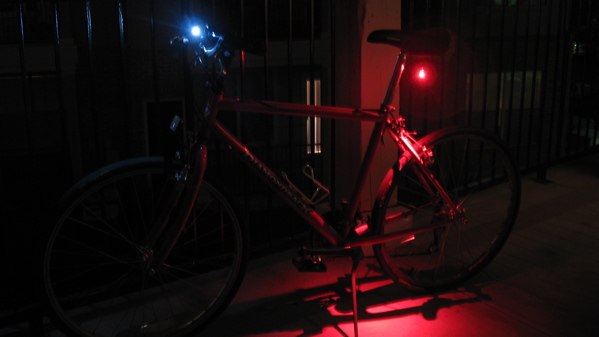 Here in the US, it's autumn and we're losing daylight quickly. It's staying dark until later in the morning, and nightfall is happening earlier every day. Those of us who were commuting by bike in full daylight just a few months ago are left with only a few options if we wish to continue riding to work: Leave later in the day, or use some really good lighting... but what if your lighting goes south?
Here in the US, it's autumn and we're losing daylight quickly. It's staying dark until later in the morning, and nightfall is happening earlier every day. Those of us who were commuting by bike in full daylight just a few months ago are left with only a few options if we wish to continue riding to work: Leave later in the day, or use some really good lighting... but what if your lighting goes south?
Battery runtime and power output are reduced in the cold. Bulbs burn out. Blinky lights can fall off and get lost or simply break. What if you're out in the dark longer than expected? These are only a few of the reasons that your lighting might fail. While it's no secret that I might go a little overboard on safety, do you really want to be riding in the dark without being seen?
My usual lighting setup is a NiteRider Evolution rigged with a 15W bulb as opposed to the 10W stock bulb. This system can only deliver about 90 minutes of full brightness, and another 15 minutes of usable-yet-dimming light. This is usually more than sufficient for my hour-long morning commute in the dark. On the back, I use a helmet-mounted Blackburn Mars 3.0. My road bike also has a permanently-mounted Trek DiscoTech on the rack. The Mars is very bright, but requires a small screwdriver to open. When the rechargeable AAA batteries I use get low, the Mars falls on its face in a hurry. It still flashes, but takes a severe nose-dive in brightness and it becomes useless pretty quick. In foul weather, I won't be using the road bike, so the rack-mounted tail light won't be there to help me out.
The two small flashlights shown above with my Trek Incite 11i for size comparison are my backup lighting solution. They're Photon MicroLight IIs. I purchased one with a red LED back in 1996 or so when they first came out so that I could easily read star charts with my dad, and for camping. The light is bright enough to be usable as a walking flashlight, but a good red color to not destroy your night vision. The white LED one I got for free from the Dis.org crew at the DefCon convention in Las Vegas in 1997. They feature replaceable batteries and a functional on-off switch as well as a squeeze mode, making them pretty versatile. They handle getting wet but I wouldn't use them under water. They can go for days on a battery, so they stand up to hours of use at a time and can last years with regular use between battery changes. Each of these lights is probably on its third or fourth battery replacement, not bad for 10 or 11 years old.
When I started bicycling a year ago, I started carrying the white one with me to use in case I needed to get the chain put back on my wal-mart beater bike or make some other impromptu adjustment. It wasn't long before I found out that tying some old hair elastics onto both lights would give me functional but worst-case-scenario lighting that could easily be attached to my bike.
Other options are carrying a spare bulb and batteries for your lights or buying some compact bicycle-specific lighting such as the Knog Frog lights. I personally think that carrying spare batteries just for an emergency is a bit cumbersome, and to make matters worse, my Mars 3.0 requires a small screwdriver to open. The philips-driver on my Park MTB-3 is too large, so that would mean carrying a small screwdriver as well. That's a deal-breaker. Solutions like the Frog or my MicroLight II will easily tuck into your jersey pocket or seat-bag with your flat repair gear.
Poking around PhotonLight.com's Keychain Lights, there are some other options that might be more cost-effective for you. The X-Light, for example, is cheaper than the MLII and has the ability to strobe. I'm not getting paid to push their products, but I've been a satisfied user of their products for more than a decade.
Here's a parting photo of my emergency lighting on my Diamondback Outlook. When wrapped around my seat's frame rails, the red light flails all over the place while riding. When seen from behind, this is very eye-catching. The MicroLight LEDs are visible from a wide angle, which helps too. The white LED is definitely more of a to-be-seen light and a pothole spotter than anything else. If I had to resort to this setup, I'd need to ride very slowly and limp home unless there was adequate street lighting available.
Sunday, October 07, 2007
Tricks of the trade: Backup Lighting
Subscribe to:
Post Comments (Atom)
Privacy Policy
This site is driven by software that uses third-party cookies from Google (Blogger, AdSense, Feedburner and their associates.) Cookies are small pieces of non-executable data stored by your web browser, often for the purpose of storing preferences or data from previous visits to a site. No individual user is directly tracked by this or any other means, but I do use the aggregate data for statistics purposes.
By leaving a link or e-mail address in my comments (including your blogger profile or website URL), you acknowledge that the published comment and associated links will be available to the public and that they will likely be clicked on.
By leaving a link or e-mail address in my comments (including your blogger profile or website URL), you acknowledge that the published comment and associated links will be available to the public and that they will likely be clicked on.



No comments:
Post a Comment